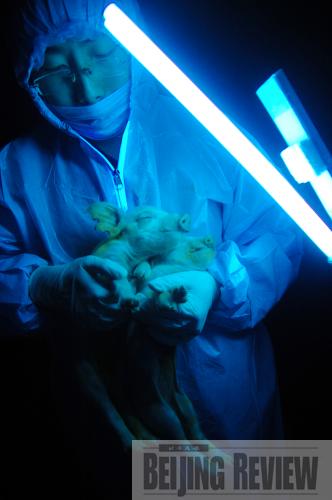|
 |
|
GENETIC MAGICS: Bred by Northeast Agricultural University in Harbin, Heilongjiang Province, China's first cloned pig whose genes were altered to make it glow fluorescent green has passed on the trait to its young, a development that could lead to the future breeding of pigs for human transplant organs (CFP) |
Chinese scientists recently announced that they have succeeded in changing cells from pigs into ones like embryonic stem cells, which are capable of developing into any other type of cell in the body in a phenomenon called pluripotency.
This is the first time anyone in the world has made pluripotent stem cells from somatic cells (as opposed to germline cells such as sperm and eggs) from an ungulate (an animal that has hooves). Scientists at the Shanghai Institute of Biochemistry and Cell Biology (SIBCB), part of the Chinese Academy of Sciences, achieved the breakthrough.
"This is the first report in the world of the creation of domesticated ungulate pluripotent stem cells," Dr. Xiao Lei, head of the SIBCB stem cell lab, told Xinhua News Agency. The work was first published in the newly launched Journal of Molecular Cell Biology, a new international journal publishing authoritative reviews and high-quality, original articles in all areas of molecular and cell biology.
Researchers hope the discovery will open the door to making human disease models, engineering animals as sources of organs for transplant into humans and developing pigs that are resistant to diseases like the A/H1N1 flu.
Xiao and his colleagues took cells from the ears and bone marrow of pigs and reprogrammed them using genetically engineered viruses. They then coaxed them to develop into colonies of induced pluripotent stem cells (iPS cells). The iPS cells are very similar to embryonic stem cells, which are regarded as the "gold standard" in stem cell research. Further tests showed that, like embryonic stem cells, the new iPS pig cells were capable of differentiating into the types of cells that form the organ, bone, muscle, blood, skin and nerve tissues of embryos.
The work related with iPS cells can provide information that should make it easier to develop embryonic stem cells (ES cells) from pigs or other ungulate embryos, said the researchers.
| 